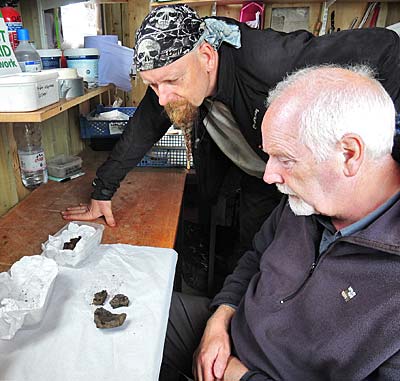Introducing ceramics 4 – why the changes?

The hunt is on for clues, for any evidence of change through time. If you are a historian that can come in a dusty library as you leaf through old documents.
If you are an archaeologist, kneeling in a muddy trench as a chill wind whistles around your extremities, it can come with the discovery of an unusual pot sherd, different to the ones already found and showing that at some time in the story of your site people began to do things differently.
That happens at the Ness.
It can be (and was) a body sherd with an unusual angle, which indicated a carinated round-based bowl which, in general terms, pre-dates Grooved Ware.
We have two of them now.

Or it can be a finer rim with horizontal incised lines just below the rim exterior and, below that, incised zig-zag patterns, all of it indicating a type of pottery following Grooved Ware and maybe into the early Bronze Age.
It’s exciting stuff, and although it indicates change, it does not suggest sudden change.
As we tell visitors, nobody woke up on a Thursday morning c2500 cal BC and said: “We’re almost in the Bronze Age now. Let’s make Beakers.”
Yet change happened.
We know that the advent of Grooved Ware appears to have coincided with significant changes in Neolithic society generally.
A new age of competition, of conspicuous consumption, perhaps of local or wider alteration in the ordering of societies was coming and, as we lack the written documents of historians, we track these changes through studying the material culture revealed through archaeology.
In other words, people did things differently over time, but why?

At the Ness we have deeply stratified remains stretching over a millennium or more. This helps to identify changes in the pottery we find. Grooved Ware was in use from around 3200 cal BC. but in the next 700 or so years it changed.
We only have space here for generalisations, but the earlier Grooved Ware was relatively fine with incised decoration and sometimes smashed shell as a temper in the clay.
It was well made, useful, pottery and it probably co-existed with some round-based vessels for a while.
Over time it changed.
Larger amounts of smashed rock temper made it difficult to used incised decoration and other types appeared, most notably towards the end of the period, consisting of strips of clay (applied cordons) arranged on the exterior surface in decorative bands.
Again towards the end, around 2500 cal BC the pottery had become frequently thick and ungainly, badly fired and liable to crack and crumble.
Decoration often looked as if it had been done in a hurry by someone with bad eyesight. One distinguished professor described it as “rubbish”.
What had happened?

Neolithic pottery in general is fired at low temperatures, perhaps not much more than needed to bring about the ceramic change around 600 degrees C.
Many of the broken Ness sherds have a dark band in the middle of the body indicating organic material persisting because of the low temperature.
Our problem is that the earlier Grooved Ware appears to have been fired at a higher temperature, for a longer period, or both. We know now that the length of firing is at least as important as the temperature achieved.

Unfortunately, we do not know why this happened.
Over time, was there a change in the technical capabilities of the potters or in the way they were viewed/viewed themselves in society? Could it be their pottery became less valuable or well-regarded?
Might there have been a shortage of fuel for firing? Peat ash is abundant at the Ness, but peat would have been a valuable commodity, perhaps too valuable for firing pot. On the other hand, dried seaweed is a very good alternative fuel and there is undoubtedly plenty of that in Orkney.
We hope that our Ness research will begin to unravel these problems.
In the next section we will examine the actual firing of Neolithic pot and answer the question … what did they use it for?














